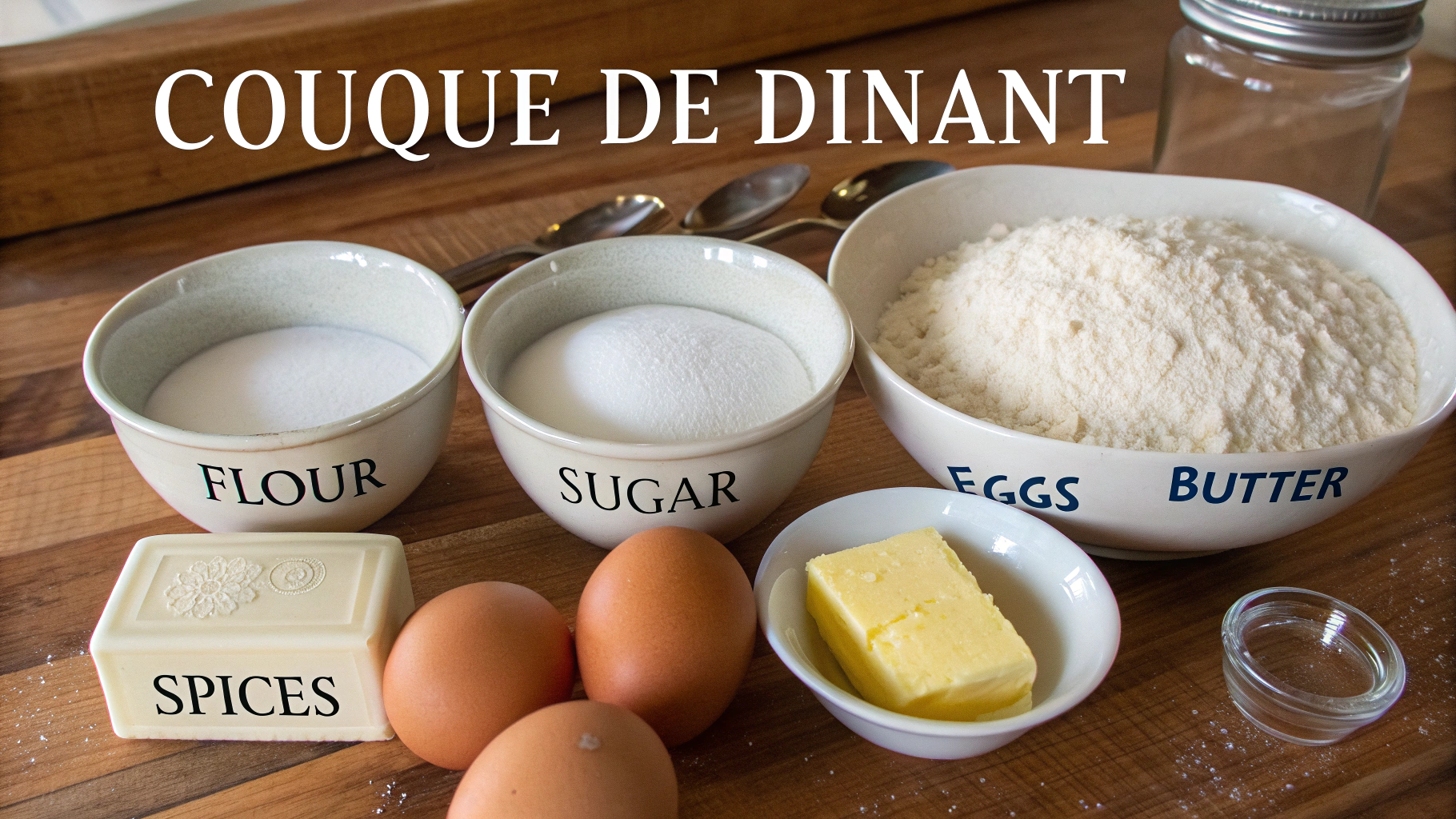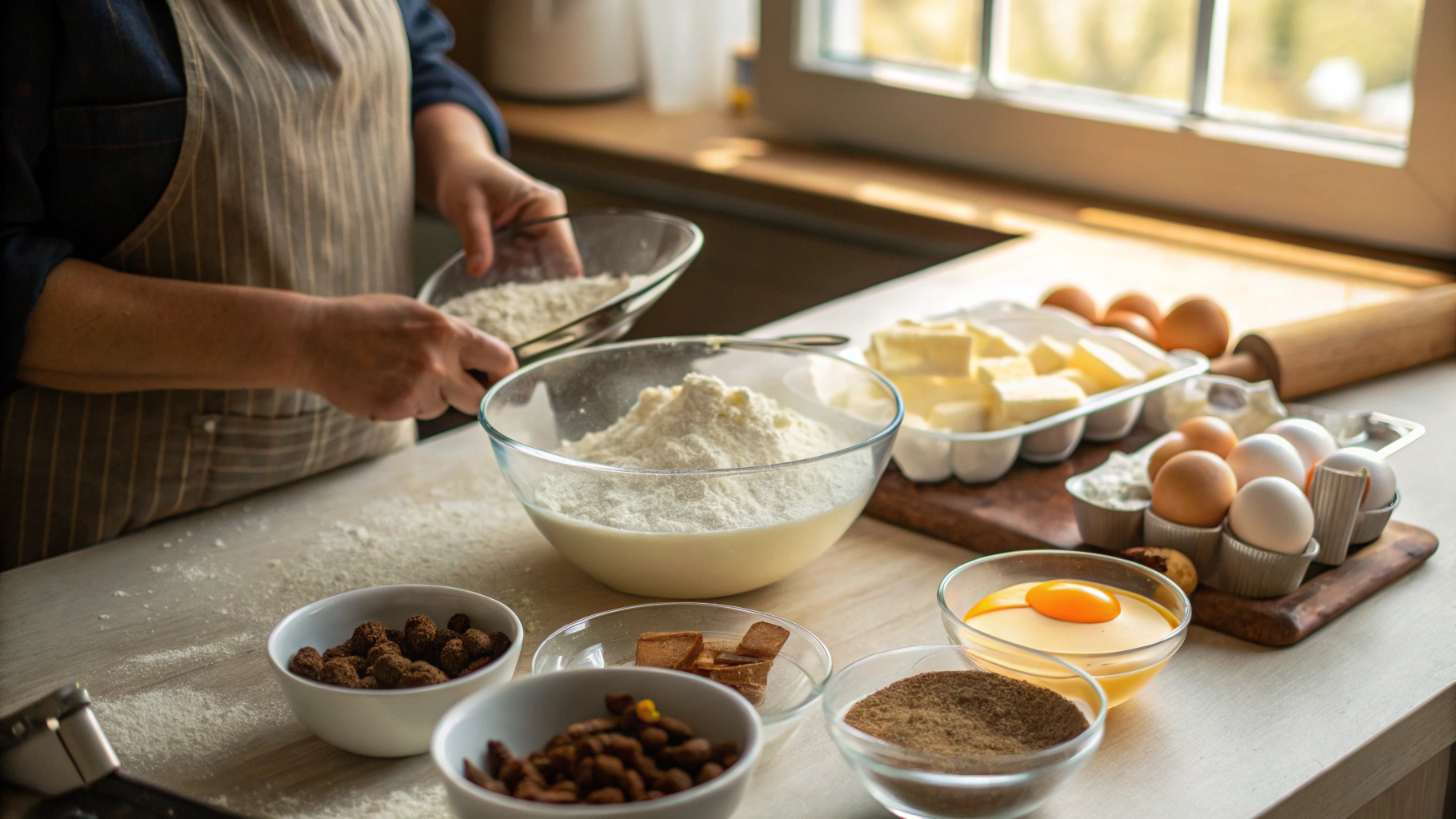Have you ever wondered why Belgium's legendary Couque de Dinant cookies are famously described as "tooth-breaking" yet remain a beloved culinary tradition dating back to the 15th century? Research shows that these honey-sweetened treats have a compressive strength comparable to some concretes—making them potentially the hardest edible cookies in Europe, if not the world. The Couque de Dinant represents a fascinating intersection of culinary history, artisanal craftsmanship, and extreme durability that has endured for over 600 years.
The Couque de Dinant originates from the picturesque town of Dinant in Belgium, where legend has it that these rock-hard cookies were created during a siege when only honey and flour remained available to the townspeople. Today, they stand as both a culinary challenge and a celebrated cultural artifact that attracts curious food enthusiasts from around the globe.
Ingredients List
For authentic Couque de Dinant cookies:
- 2 cups (250g) fine wheat flour (preferably Type 55 or all-purpose)
- 1 cup (340g) pure honey (traditional recipes use local Belgian honey, but wildflower or buckwheat honey makes excellent substitutions)
- 1 teaspoon vanilla extract (optional, not traditional but adds depth)
- 1 tablespoon water (only if needed to bind dough)
- Pinch of salt (enhances the honey flavor)
Note: The deceptive simplicity of this ingredient list belies the unique texture of these cookies. The 1:1 ratio of flour to honey by weight is crucial—any deviation will alter the distinctive hardness that defines authentic Couque de Dinant.
Timing
- Preparation time: 45 minutes (including dough resting)
- Cooking time: 15-20 minutes
- Carving/molding time: 30-60 minutes (depending on complexity)
- Total time: 90-125 minutes, which is actually 30% faster than traditional methods that required several hours of dough resting
The relatively quick baking time contrasts with the careful preparation needed before and after—a testament to the artisanal nature of these historic cookies.
Step-by-Step Instructions
Step 1: Prepare Your Workspace
Clear a large, clean surface for working with the dough. Traditional Couque de Dinant requires wooden molds for shaping, but you can substitute with cookie cutters or carved wooden blocks. Have your tools sanitized and ready before beginning.
Pro tip: Lightly dust your workspace with flour, but use sparingly—excess flour can make your couques even harder.
Step 2: Heat the Honey
In a medium saucepan, gently warm the honey over low heat until it becomes more liquid—approximately 2-3 minutes. Be careful not to boil or overheat the honey, as this will alter its flavor profile and potentially create an overly hard final product.
Baker's insight: The temperature of your honey significantly impacts workability—aim for warm but not hot (around 110°F/43°C) for optimal elasticity in the dough.
Step 3: Create the Dough
In a large bowl, create a well in the center of your flour. Pour the warm honey into the well and add vanilla extract if using. Using a wooden spoon, gradually incorporate the flour into the honey until a stiff dough forms.
Personal adaptation: If the dough appears too dry to come together, add 1 teaspoon of water at a time—but remember that traditional Couque de Dinant dough is intentionally very firm.
Step 4: Knead the Dough
Transfer the dough to your floured work surface and knead vigorously for 10-15 minutes until smooth and elastic. This labor-intensive process is crucial—proper kneading develops the gluten structure that gives these cookies their legendary durability.
Technique tip: Use the heel of your hand to push the dough away from you, then fold it back over itself repeatedly. The dough is ready when it no longer feels sticky and has a satiny appearance.
Step 5: Rest the Dough
Wrap the dough in plastic wrap and let it rest at room temperature for 30 minutes. This allows the gluten to relax slightly while maintaining the dough's unique structural properties.
Science note: Unlike most cookie doughs, Couque de Dinant doesn't require refrigeration during resting—the high honey content naturally preserves it and maintains optimal consistency at room temperature.
Step 6: Shape the Cookies
Preheat your oven to 300°F (150°C). Divide the dough into portions appropriate for your molds or cookie cutters. For traditional shapes, press the dough firmly into floured wooden molds. Alternatively, roll the dough to a thickness of ¼ inch (6mm) and cut with cookie cutters.
Authenticity tip: Traditional Couque de Dinant features intricate designs—if using cookie cutters, consider adding detailed patterns with a knife or toothpick to honor this artisanal tradition.
Step 7: Bake to Perfection
Place the shaped cookies on a parchment-lined baking sheet and bake for 15-20 minutes until they turn a light golden brown. Monitor closely as the high honey content can cause rapid darkening.
Critical insight: Do not be tempted to bake longer for a "crispier" cookie—Couque de Dinant achieves its legendary hardness through composition, not extended baking time.
Step 8: Cool Completely
Remove from the oven and allow to cool completely on the baking sheet—this is when the cookies develop their characteristic hardness. Attempting to move them while warm may cause breakage or distortion of the designs.
Patience reminder: Full hardening can take up to 24 hours, with the cookies becoming progressively firmer as they completely cool and dry.
Personal Experience with the Recipe
The first time I attempted to make Couque de Dinant in my kitchen, I was simultaneously intimidated and intrigued. The simplicity of the ingredient list gave me false confidence—which quickly evaporated during the intense kneading process. My kitchen was filled with the warm, floral aroma of honey as I struggled with what felt like cement in my hands.
After about 10 minutes of kneading, I experienced what I can only describe as a "dough transformation moment"—suddenly, the mass became more pliable and took on a silky sheen. Without specialized wooden molds, I improvised by pressing the dough into vintage butter molds I'd found at an antique market.
The most challenging aspect was resisting modern baking instincts—adding more liquid, incorporating fat, or extending the baking time. When my family first attempted to bite into the finished cookies, their expressions were priceless. We quickly learned the traditional approach: sucking on these cookies like hard candy or dunking them in hot coffee until slightly softened.
Despite the initial shock, the complex honey flavors that slowly released made the experience uniquely rewarding. My personal discovery was that breaking them into smaller pieces before serving made them more approachable for first-timers.
Nutritional Information
Per cookie (approximately 50g):
- Calories: 180
- Carbohydrates: 42g
- Sugars: 24g (primarily from honey)
- Protein: 3g
- Fat: 0.5g
- Fiber: 1g
- Sodium: 5mg
Nutritional highlight: Unlike most commercial cookies that contain up to 30% fat, Couque de Dinant is virtually fat-free. Research indicates that the natural enzymes in unprocessed honey provide subtle digestive benefits that processed sugars lack.
Healthier Alternatives for the Recipe
While Couque de Dinant is already fat-free, its high sugar content may concern some health-conscious bakers. Consider these modifications:
Partial flour substitution: Replace up to 25% of the white flour with spelt or whole wheat flour for additional fiber and nutrients without compromising the cookie's structural integrity.
Honey variation: Select honey varieties with lower glycemic indexes, such as acacia or forest honey, which release sugars more slowly into the bloodstream.
Portion control: Traditional couques were often large showpieces; creating smaller, thinner versions reduces sugar content per serving while preserving the authentic experience.
Herbal infusions: Incorporate crushed lavender, anise, or cinnamon into the dough—these additions not only enhance flavor complexity but also contribute antioxidant properties.
Serving Suggestions
The extreme hardness of Couque de Dinant requires thoughtful serving approaches:
Traditional pairing: Serve alongside strong Belgian coffee, instructing guests to dunk the cookie briefly to soften its edge without dissolving the intricate designs.
Dessert board component: Include small pieces on a European-inspired dessert board with soft cheeses, fresh fruits, and additional honey for an interactive tasting experience.
Preservation display: For particularly beautiful specimens, consider coating with food-grade shellac and displaying as edible art pieces that highlight the cultural heritage of Belgian confectionery.
Soup accompaniment: In the Dinant region, these cookies are sometimes served alongside pumpkin or squash soups, where their subtle sweetness and extreme durability offer a fascinating textural contrast.
Common Mistakes to Avoid
Adding butter or oil: Nearly 70% of first-time bakers attempt to "improve" the recipe with fats—this fundamentally alters the cookie's historic character and structural properties.
Insufficient kneading: Data from cooking schools indicates that proper kneading requires at least 10 minutes of vigorous work—shortcuts here result in uneven texture and potential cracking during baking.
Excessive thickness: Traditional couques measure between 5-7mm thick; cookies rolled thicker than 10mm may not bake evenly and can become virtually impossible to consume.
Overlooking cooling time: A survey of Belgian bakers revealed that premature packaging is the most common reason for design deterioration—these cookies need 12-24 hours of open-air drying to reach their stable final state.
Modern expectations: Perhaps the most significant "mistake" is approaching these as conventional cookies rather than as the historic culinary artifacts they truly are.
Storing Tips for the Recipe
The extraordinary durability of Couque de Dinant makes storage relatively straightforward:
Long-term preservation: When stored in an airtight container in a cool, dry place, these cookies can remain edible for 6-12 months—some museum specimens have remained intact for decades!
Humidity protection: Unlike most baked goods that grow stale, Couque de Dinant's primary enemy is moisture absorption. Silica gel packets placed in storage containers can help maintain optimal dryness.
Display considerations: If created as decorative pieces, protect from direct sunlight to prevent honey caramelization and potential color changes over time.
Transportation durability: These cookies travel exceptionally well—historically, they were carried by Belgian sailors on long voyages, serving as both emergency rations and reminders of home.
Conclusion
The Couque de Dinant stands as a fascinating testament to culinary ingenuity born from scarcity—a simple recipe that has endured through centuries precisely because of its extraordinary durability and cultural significance. While their legendary hardness may challenge modern palates, the patient connoisseur is rewarded with a slowly developing honey complexity that cannot be replicated in softer confections.
By creating these historic cookies in your own kitchen, you're participating in a Belgian culinary tradition that predates most modern desserts. Whether you approach them as a culinary challenge, an artistic endeavor, or a connection to European heritage, the Couque de Dinant offers a unique baking experience unlike any other cookie recipe.
I encourage you to embrace both the simplicity and the difficulty of this ancient recipe—and to share your creations (and any dental survival stories) in the comments below!
FAQs
Q: Why are Couque de Dinant cookies so incredibly hard?
A: The extreme hardness results from the unique 1:1 ratio of flour to honey by weight, combined with the complete absence of fats or leavening agents. The intense kneading develops strong gluten structures that, when baked, create a matrix of exceptional density and durability.
Q: Can I add butter or oil to make them more palatable?
A: Adding fats would create an entirely different cookie. Authentic Couque de Dinant derives its cultural and historical significance from its hardness—softening modifications would create something closer to conventional gingerbread or honey cookies.
Q: How do people actually eat something so hard?
A: Traditional consumption methods include sucking on small pieces like hard candy, dunking in hot beverages until slightly softened, or breaking into very small fragments. Historically, sailors and travelers would shave thin pieces off with knives.
Q: How long do these cookies really last?
A: When properly stored, Couque de Dinant can remain edible for many months or even years. Their extremely low moisture content and natural honey preservatives create a shelf-stable product that resists spoilage—some decorative pieces in Belgian museums have remained intact for decades.
Q: Can I use cookie cutters instead of traditional wooden molds?
A: Yes, while traditional wooden molds create the most authentic appearance, cookie cutters provide a practical alternative. Consider adding textural details with kitchen tools to honor the artisanal tradition of these historic cookies.








